| Listing 1 - 10 of 156 | << page >> |
Sort by
|
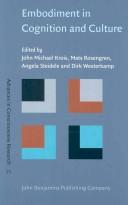
ISBN: 128215284X 9786612152849 9027292191 9789027292193 9027252076 9789027252074 9789027252074 9781282152847 6612152842 Year: 2007 Publisher: Amsterdam ; Philadelphia : John Benjamins Pub. Co.,
Abstract | Keywords | Export | Availability | Bookmark
 Loading...
Loading...Choose an application
- Reference Manager
- EndNote
- RefWorks (Direct export to RefWorks)
This volume shows that the notions of embodied or situated cognition, which have transformed the scientific study of intelligence have the potential to reorient cultural studies as well. The essays adapt and amplify embodied cognition in such different fields as art history, literature, history of science, religious studies, philosophy, biology, and cognitive science. The topics include the biological genesis of teleology, the dependence of meaning in signs upon biological embodiment, the notion of image schema and the concept of force in cognitive semantics, pictorial self-portraiture as a means to study self-perception, the difference between reading aloud and silent reading as a way to make sense of literary texts, intermodal (kinesthetic) understanding of art, psychosomatic medicine, laughter as a medical and ethical phenomenon, the valuation of laughter and the body in religion, and how embodied cognition revives and extends earlier attempts to develop a philosophical anthropology. (Series A).
Cognition and culture. --- Cognition. --- Psychology --- Culture and cognition --- Cognition --- Culture --- Ethnophilosophy --- Ethnopsychology --- Socialization
Book
ISBN: 1108621171 1107446805 110858022X 1107060281 9781107060289 1107629802 Year: 2018 Publisher: Cambridge : Cambridge University Press,
Abstract | Keywords | Export | Availability | Bookmark
 Loading...
Loading...Choose an application
- Reference Manager
- EndNote
- RefWorks (Direct export to RefWorks)
Bodies and Other Objects is written for students, scholars and anyone with an interest in embodied cognition - the claim that the human mind cannot be understood without regard for the actions and capacities of the body. The impulse to write this book was a dissatisfaction with the inconsistent, and often shallow, use of the term 'embodied cognition'. This text attempts to reframe cognitive science with a unified theory of embodied cognition in which sensorimotor elements provide the basis for cognition, including symbolic exchanges that arise within a society of agents. It draws ideas and evidence from experimental psychology, neuroscience, philosophy and anthropology in reaching the conclusion that human cognition is best understood as the means by which exchanges within a constantly evolving network of skilful bodies and objects are regulated so as to further human interests.
Cognition. --- Cognition and culture. --- Culture and cognition --- Cognition --- Culture --- Ethnophilosophy --- Ethnopsychology --- Socialization --- Psychology
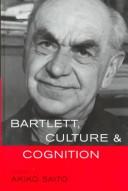
ISBN: 0415201721 Year: 2000 Publisher: [s.l.] Psychology press
Abstract | Keywords | Export | Availability | Bookmark
 Loading...
Loading...Choose an application
- Reference Manager
- EndNote
- RefWorks (Direct export to RefWorks)
Cognitie en cultuur --- Cognition and culture --- Cognition et culture --- #PBIB:2000.3 --- Culture and cognition --- Cognition --- Culture --- Ethnophilosophy --- Ethnopsychology --- Socialization
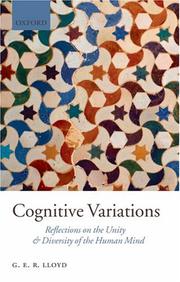
ISBN: 9780199566259 9780199214617 0199214611 0191706493 0199566259 9786611149352 0191526835 1281149357 1435621646 Year: 2007 Publisher: Oxford Clarendon Press
Abstract | Keywords | Export | Availability | Bookmark
 Loading...
Loading...Choose an application
- Reference Manager
- EndNote
- RefWorks (Direct export to RefWorks)
Cognition and culture --- Culture and cognition --- Cognition --- Culture --- Ethnophilosophy --- Ethnopsychology --- Socialization --- Cognitive psychology --- Philosophy and psychology of culture

ISBN: 9789027252074 Year: 2007 Publisher: Amsterdam Benjamins
Abstract | Keywords | Export | Availability | Bookmark
 Loading...
Loading...Choose an application
- Reference Manager
- EndNote
- RefWorks (Direct export to RefWorks)
Cognition and culture --- Culture and cognition --- Cognition --- Culture --- Ethnophilosophy --- Ethnopsychology --- Socialization --- Philosophy and psychology of culture --- Philosophical anthropology --- Cognitive psychology
Book
ISBN: 1474288693 1474235050 1472584201 9781472584205 9781472584199 1472584198 9781474235051 9781472584212 147258421X 9781474288699 Year: 2015 Publisher: New York
Abstract | Keywords | Export | Availability | Bookmark
 Loading...
Loading...Choose an application
- Reference Manager
- EndNote
- RefWorks (Direct export to RefWorks)
"The Roman cult of Mithras was the most widely-dispersed and densely-distributed cult throughout the expanse of the Roman Empire from the end of the first until the fourth century AD, rivaling the early growth and development of Christianity during the same period. As its membership was largely drawn from the ranks of the military, its spread, but not its popularity is attributable largely to military deployments and re-deployments. Although mithraists left behind no written archival evidence, there is an abundance of iconographic finds. The only characteristic common to all Mithraic temples were the fundamental architecture of their design, and the cult image of Mithras slaying a bull. How were these two features so faithfully transmitted through the Empire by a non-centralized, non-hierarchical religious movement? The Minds of Mithraists: Historical and Cognitive Studies in the Roman Cult of Mithras addresses these questions as well as the relationship of Mithraism to Christianity, explanations of the significance of the tauroctony and of the rituals enacted in the mithraea, and explanations for the spread of Mithraism (and for its resistance in a few places). The unifying theme throughout is an investigation of the 'mind' of those engaged in the cult practices of this widespread ancient religion. These investigations represent traditional historical methods as well as more recent studies employing the insights of the cognitive sciences, demonstrating that cognitive historiography is a valuable methodological tool."--Bloomsbury Publishing.
Mithraism. --- Cognition and culture. --- Culture and cognition --- Cognition --- Culture --- Ethnophilosophy --- Ethnopsychology --- Socialization --- Mithras (Zoroastrian deity) --- Zoroastrianism --- Mithraism --- Cognition and culture
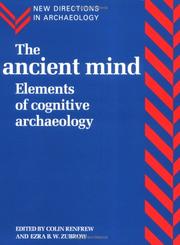
ISBN: 9780521456203 9780511598388 9780521434881 0511598386 Year: 1994 Publisher: Cambridge Cambridge University Press
Abstract | Keywords | Export | Availability | Bookmark
 Loading...
Loading...Choose an application
- Reference Manager
- EndNote
- RefWorks (Direct export to RefWorks)
One of the most troubling problems in archaeology is to determine the manner and content of prehistoric thought. A fundamental challenge is to develop the theory, methodology and tools to understand human cognition. Cognitive archaeology as a subject is still in its infancy, and archaeologists are adopting a variety of approaches. One direction has been to develop an 'interpretationist', anti-scientific, literary approach. Another has been to use a linguistic framework and develop a hermeneutic, semiotic approach. A third approach develops a new direction in prehistoric cognitive research which is rooted in the scientific tradition and in an empirical methodology. It draws upon the cognitive, the mathematical and the computer sciences in an attempt to understand what techniques can be used appropriately on archaeological data, and how to implement them efficiently. This is the approach adopted by the contributors to The Ancient Mind. Together, they begin to develop a science of cognitive archaeology.
Archaeology --- Cognition and culture --- Culture and cognition --- Cognition --- Culture --- Ethnophilosophy --- Ethnopsychology --- Socialization --- Archeology --- Anthropology --- Auxiliary sciences of history --- History --- Antiquities --- E-books --- Archaeology. --- Cognition and culture.
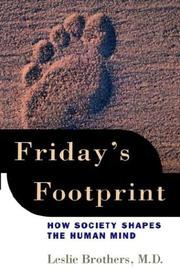
ISBN: 1280532106 0198026161 1423745795 0195349075 1602567611 9781423745792 0195147049 9786610532100 6610532109 9780195147049 0195147049 0197735533 Year: 2001 Publisher: Oxford New York Oxford University Press
Abstract | Keywords | Export | Availability | Bookmark
 Loading...
Loading...Choose an application
- Reference Manager
- EndNote
- RefWorks (Direct export to RefWorks)
Revealing the brain as a social organ, adapted to respond to and process specific social stimuli that are unique to human evolution, Dr Leslie Brothers uses findings from neuroscience, anthropology and palaeontology to make a convincing argument.
Cognition --- Cognition and culture. --- Human information processing --- Culture and cognition --- Culture --- Ethnophilosophy --- Ethnopsychology --- Socialization --- Information processing, Human --- Bionics --- Information theory in psychology --- Perception --- Social aspects.
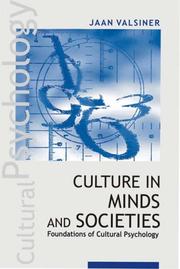
ISBN: 1282017756 9786612017759 8132101383 9788132101383 9781282017757 9780761935827 0761935827 Year: 2007 Publisher: Thousand Oaks, Calif.
Abstract | Keywords | Export | Availability | Bookmark
 Loading...
Loading...Choose an application
- Reference Manager
- EndNote
- RefWorks (Direct export to RefWorks)
This book presents a new look at the relationship between people and society, produces a semiotic theory of cultural psychology and provides a dynamic treatment of culture in human lives.
Culture --- Social sciences --- Semiotics --- Cognition and culture. --- Culture and cognition --- Cognition --- Ethnophilosophy --- Ethnopsychology --- Socialization --- Semeiotics --- Semiology (Linguistics) --- Semantics --- Signs and symbols --- Structuralism (Literary analysis) --- Psychological aspects. --- Methodology.
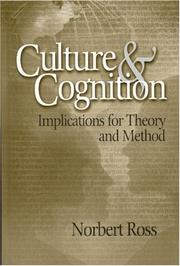
ISBN: 1452263000 1322419035 1452229716 9781452263007 9781452229713 0761929061 076192907X 9780761929062 9780761929079 9781322419039 Year: 2004 Publisher: Thousand Oaks, Calif. SAGE Publications
Abstract | Keywords | Export | Availability | Bookmark
 Loading...
Loading...Choose an application
- Reference Manager
- EndNote
- RefWorks (Direct export to RefWorks)
Norbert Ross presents an overview of approaches to the discussion of culture & cognition, discussing methodological problems as well as theoretical implications of these approaches. Also, he studies methods & statistical tools that have recently been developed to address theoretical problems.
Cognition and culture. --- Psychology. --- Behavioral sciences --- Mental philosophy --- Mind --- Science, Mental --- Human biology --- Philosophy --- Soul --- Mental health --- Culture and cognition --- Cognition --- Culture --- Ethnophilosophy --- Ethnopsychology --- Socialization
| Listing 1 - 10 of 156 | << page >> |
Sort by
|

 Search
Search Feedback
Feedback About UniCat
About UniCat  Help
Help News
News